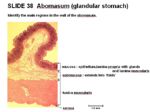Abomasum - Anatomy & Physiology
|
|
Introduction
The abomasum is the fourth chamber in the ruminant. It functions similarily to the carnivore stomach as it is glandular and functions to digest food chemically, rather than mechanically or by fermentation like the other 3 chambers of the ruminant stomach.
The abomasum differs in its position within the abdomen, depending on fullness of the other chambers of the stomach, intrinsic abomasonal activity, contractions of the rumen and reticulum (to which it is attached) and by age and pregnancy.
Displacement of the abomasum to the left or to the right is a common disorder affecting dairy cows due to high concentrate feed.
Structure
- Lies upon the abdominal floor
- Cranial part split into pylorus and body
- Caudal part
- Covered by lesser omentum
- 15-20 folds inside
- Torus at pyloric exit
- Outflow fairly constant
- Motility at pylorus (peristalsis)
- Some control at pyloric sphincter
- Large in newborn
- Proximal ends of the abomasal folds forms a plug preventing reflux into the omasum
- Thin walls
- Serousa covering
Function
- Chemical breakdown of food
- Secretes hydrochloric acid and pepsinogen
- Some intrinsic motility
- Impaired motility can cause distension
- Movements are slow
- Contraction first of proximal part
- More forceful contraction at pyloric part
Vasculature
- Cranial mesenteric artery
- Celiac artery
- Left gastric and left gasrtoepiploic arteries
Innervation
- Dorsal vagus nerve (CN X)
- Ventral vagus nerve (CN X) (most important)
Lymphatics
- Single lymph nodules are present at the junction between epithelium and lamina propria
- Numerous small lymph nodes are scattered in the abomasal curvatures
- The lymph drains to larger atrial nodes between the cardia and omasum, then to the hepatic lymph nodes
Histology
- Simple columnar epithelium
- 3 layers of tunica muscularis- inner oblique, middle circular and outer longitudinal
- Lamina muscularis thicker (3 separate layers)
- Gastric glands in lamina propria of mucosal layer in pyloric region (lighter part)
- Heavily coated by mucous for protection
- Submucosa contains loose connective tissue, many blood vessels and unilocular adipocytes
- Deep gastric pits
- Coiled glands in lamina propria opening into gastric pits
- Pink inner mucosa
- Rugae are present in the pyloric region
- Torus (large swelling) is present at the pyloric passage to narrow the lumen
- Dark mucosa of fundus and body contain peptic glands
Species Differences
Small Ruminants
- Abomasum can contact liver
- Abomasum is proportionately larger than in cattle
Links
The Rumen - Anatomy & Physiology
The Reticulum - Anatomy & Physiology
The Omasum - Anatomy & Physiology
Video
Pot 52 Lateral view of the Abdomen of a young Ruminant
Pot 175 Sections of the Ruminant Stomach
Pot 47 Ovine Omasum and Abomasum
Left sided topography of the Ovine Abdomen and Thorax

